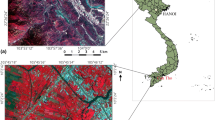Abstract
Remote sensing-based crop mapping using multispectral temporal images is a reliable source of crop status information. Reflectance in red-edge region can be incorporated in vegetation indices for better results as it heavily depends upon chlorophyll content in the leaves. This research work studies the effect of three Sentinel-2 red-edge bands on fuzzy classification of sunflower crop in Shahabad, Haryana, India. Fuzzy set theory was introduced in the image processing for handling the mixed pixel problems. Supervised modified possibilistic c-means (MPCM) classification approach has been adopted for the identification of sunflower fields due to the capability of handling outliers, noises, extraction of single crop and coincident cluster problem. Classification approach was applied on four different modified temporal vegetation indices. The modified vegetation indices are generated by taking different combinations of red and red-edge reflectance bands in a controlled manner with NIR band. The best vegetation index and suitable red-edge band for the discrimination of sunflower crop were determined. Further, optimization of temporal date images to separate mapping of early sown, middle sown and late sown fields was also identified. From the results of this study, it has been proven that for temporal datasets red-edge-based indices are better than the standard indices for distinguishing between different crops while applying the MPCM classification method.
















Similar content being viewed by others
References
Administrator. (2013). An overview of Sunflower in India—Krishisewa. Retrieved May 30, 2019, from http://www.krishisewa.com/articles/miscellaneous/284-sunflower.html.
Boochs, F., Kupfer, G., Dockter, K., & Kuhbaüch, W. (1990). Shape of the red edge as vitality indicator for plants. International Journal of Remote Sensing,11(10), 1741–1753. https://doi.org/10.1080/01431169008955127.
Chawla, S. (2010). Possibilistic c-means-spatial contextual information based sub-pixel classification approach for multi-spectral data. Enschede: International Institute for Geoinformation Science and Earth Observation.
Delegido, J., Alonso, L., Abad, G. G., & Moreno, J. (2010). Estimating chlorophyll content of crops from hyperspectral data using a normalized area over reflectance curve (NAOC). International Journal of Applied Earth Observation and Geoinformation, 12(3), 165–174. https://doi.org/10.1016/j.jag.2010.02.003.
Dongre, P. (2016). Study of similarity and dissimilarity measures with possibilistic based fuzzy classifiers. Visakhapatnam: Andhra University.
Dutta, A. (2009). Data incorporating spatial contextual information by using Markov random field fuzzy c-means classification of multispectral data incorporating spatial contextual information by using Markov random field. Twente: University of Twente.
Horler, H., Dockray, M., & Barber, P. J. (1983). The red edge of plant leaf reflectance. International Journal of Remote Sensing,4(2), 273–288. https://doi.org/10.1080/01431168308948546.
Jensen, J. R. (1996). Introductory digital image processing: A remote sensing prospective. In SERBIULA (sistema Librum 2.0).
Krishnapuram, R., & Keller, J. M. (1993). A possibilistic approach to clustering. IEEE Transactions on Fuzzy Systems,1(2), 98–110. https://doi.org/10.1109/91.227387.
Krishnapuram, R., & Keller, J. M. (1996). The possibilistic C-means algorithm: Insights and recommendations. IEEE Transactions on Fuzzy Systems,4(3), 385–393. https://doi.org/10.1109/91.531779.
Mcbratney, A., Whelan, B., Ancev, T., & Bouma, J. (2005). Future directions of precision agriculture. In 7th International conference on precision agriculture, Minneapolis, USA, July 2004, (Vol. 6(1), pp. 7–23). https://doi.org/10.1007/s11119-005-0681-8.
Misra, G. (2012). Mapping specific crops and their phenology—Multi sensor and temporal approach (University of Twente). Retrieved from http://www.itc.nl/library/papers_2012/msc/gfm/misra.pdf.
Musande, V., Kumar, A., & Kale, K. (2012). Cotton crop discrimination using fuzzy classification approach. Journal of the Indian Society of Remote Sensing,40(4), 589–597. https://doi.org/10.1007/s12524-012-0201-z.
Nandan, R., Kumar, R., Kumar, A., & Kumar, S. (2017). Wheat monitoring by using kernel based possibilistic c-means classifier: Bi-sensor temporal multi-spectral data. Journal of the Indian Society of Remote Sensing,45(6), 1005–1014. https://doi.org/10.1007/s12524-016-0651-9.
Schlemmer, M., Gitelson, A.A., Schepers, J.S., Ferguson, R.B., Peng, Y., Shanahan, J., et al. (2013). Remote estimation of nitrogen and chlorophyll contents in maize at leaf and canopy levels. International Journal of Applied Earth Observation and Geoinformation,25(1), 47–54. https://doi.org/10.1016/j.jag.2013.04.003.
Singha, M. (2013). Study the effect of discontinuity adaptive MRF models in fuzzy based classifier. Twente: University of Twente.
Tso, B., & Mather, P. M. (2010). Classification methods for remotely sensed data. Classification Methods for Remotely Sensed Data. https://doi.org/10.4324/9780203303566.
Upadhyay, P., Ghosh, S. K., & Kumar, A. (2013). Moist deciduous forest identification using temporal MODIS data—A comparative study using fuzzy based classifiers. Ecological Informatics,18, 117–130. https://doi.org/10.1016/j.ecoinf.2013.07.002.
Upadhyay, P., Ghosh, S. K., & Kumar, A. (2014). A brief review of fuzzy soft classification and assessment of accuracy methods for identification of single land cover. In Studies in surveying and mapping science (SSMS), American Society of Science and Engineering (Vol. 2, pp. 1–13) (ISSN 2328-6245 & 2328-6253).
Xie, Q., Dash, J., Huang, W., Peng, D., Qin, Q., Mortimer, H., et al. (2018). Vegetation indices combining the red and red-edge spectral information for leaf area index retrieval. IEEE Journal of Selected Topics in Applied Earth Observations and Remote Sensing,11(5), 1482–1492. https://doi.org/10.1109/JSTARS.2018.2813281.
Author information
Authors and Affiliations
Corresponding author
Additional information
Publisher's Note
Springer Nature remains neutral with regard to jurisdictional claims in published maps and institutional affiliations.
About this article
Cite this article
Vincent, A., Kumar, A. & Upadhyay, P. Effect of Red-Edge Region in Fuzzy Classification: A Case Study of Sunflower Crop. J Indian Soc Remote Sens 48, 645–657 (2020). https://doi.org/10.1007/s12524-020-01109-4
Received:
Accepted:
Published:
Issue Date:
DOI: https://doi.org/10.1007/s12524-020-01109-4




